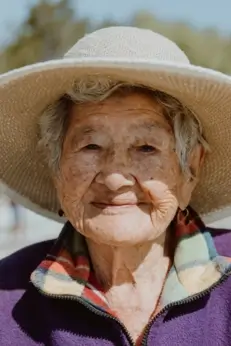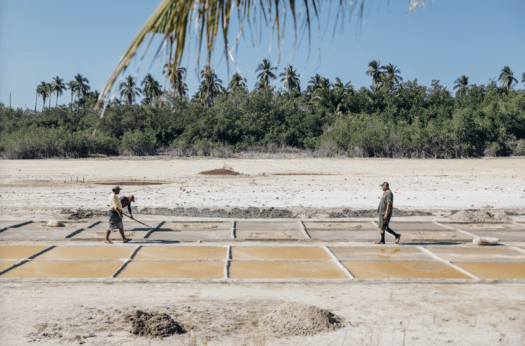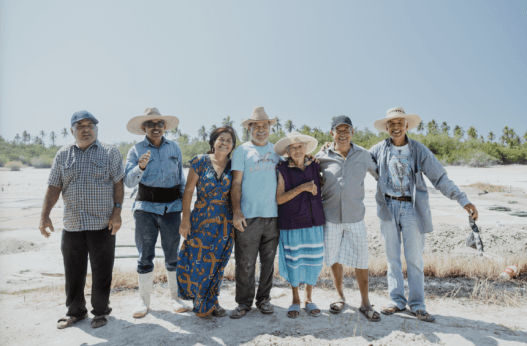Quintina Ayvar de la Cruz is the dwelling embodiment of the environment that has been her dwelling for 97 years. She has a brightness that matches the inexperienced mangroves near her residence in Juluchuca, Mexico and she or he sparkles similar to the salt that has been the primary goal of her life’s work—and an necessary provide of her life’s pleasure, too.
“I started from a youthful age, after I used to be about six years outdated,” says Ayvar de la Cruz, recalling her earliest experiences of harvesting salt from the world acknowledged throughout the neighborhood as Las Salinas. “I began with my mom and father, then continued with my brothers, then with my kids from as soon as they’d been eight.”


The work of harvesting usually begins in February or March and carries on for 3 or 4 months, counting on the local weather. The members of the Ayvar de la Cruz family are the one remaining residents of the realm to proceed harvesting salt throughout the standard means, which is accomplished absolutely by hand with the help of devices made solely from native, pure provides, fairly than relying on fashionable gear. It begins by mixing a rustic concrete from sand and clay to kind shallow sq. basins on the perimeter of the lagoon. These lagoons are then filled with every freshwater and saltwater, sooner than lime (in its mineral powder kind) is added to the small swimming swimming pools to help separate out the salt from the water. A specific rake often known as a tarecua facilitates this course of. There, the mix dries throughout the photo voltaic over the next 5 or so days and the salt is collected as quickly because the water has evaporated.


“We start at six throughout the morning,” says Ayvar de la Cruz. “We start early on account of when it’s cool, you probably can switch forward with out getting so drained. At midday, the heat turns into very sturdy.” A break is taken from spherical 11:00 AM to 4:00 PM. When the photo voltaic is way much less intense, the work continues until all of the sunshine is gone, spherical eight throughout the evening.
The occasions are prolonged and the work is tough, nevertheless Ayvar de la Cruz focuses on the experience of being on this extraordinary environment. “You feel the latest air and funky water of the mangroves. It is a feeling of freedom and tranquility.”


At a distance of 90 years or so, she’s going to nonetheless describe with spectacular readability the sensations of that first encounter with the salt flats—the feeling of being carried in her father’s arms and on the once more of a donkey as they made the journey there and, later, to the closest metropolis, Petatlán, to advertise the salt, along with its dazzling whiteness when organized proper right into a mound all through mats comprised of palm fronds after harvesting.
Over the previous decade, all completely different salt producers throughout the house have modernized the strategy. A number of the necessary changes has been the implementation of plastic sheets as the underside for the drying areas, which makes manufacturing go further quickly.
“Salt made using plastic could possibly be purchased for cheaper and it hurts our native market,” says Ayvar de la Cruz’s son, Don Alejandro. “We don’t market our salt as artisanal, nevertheless all people is conscious of spherical proper right here that we’re the one ones doing it the pure means.”


Ayvar de la Cruz laments that the salt flats are literally permeated with a “plastic odor” and her son notes that workers normally depart their gear throughout the lagoon out of season and, when hurricanes hit the coast, plastic objects can end up elsewhere, endangering native wildlife. The surrounding mangroves are a key habitat for a varied array of crops and animals, along with shrimp, fish, crabs, pink herons, deer and coati (a kind of badger), along with a form of tree acknowledged colloquially as salado (“salty”) on account of it survives in saltwater.


In 2006, the Ayvar de la Cruz family was contacted by a model new hospitality enterprise often known as Playa Viva. Its proprietor, David Leventhal, was planning to assemble a resort shut by based mostly on the concepts of regenerative tourism, and he was fascinated by learning regarding the native ecosystems and neighborhood. Playa Viva hoped that collaborating with residents akin to Ayvar de la Cruz would possibly help create an space that will allow company to experience the great thing about this stretch of the Mexican coast, whereas moreover having a constructive social and environmental affect that will linger longer than they’d.
In 2013, Playa Viva instituted the Regenerative Perception, with environmental and social aims that fluctuate from restoring ecosystems to elevating endangered species for launch and donating faculty supplies to kids. Two % of all earnings from customer reservations are channeled into these native purposes.


One in every of many predominant purposes funded by the Regenerative Perception is as ReSiMar—fast for “Regenerating from Sierra to Mar”—which refers to its house of focus, between the Sierra Madre Mountain Differ and the Pacific Ocean. Via ReSiMar, Playa Viva objectives to regenerate your complete ecosystem of this watershed. Sourcing elements from sustainable fisheries and completely different small corporations that depend on the watershed, like that of the Ayvar de la Cruz family, is part of this effort.
Playa Viva devoted to buying the salt for its restaurant solely from the Ayvar de la Cruz family and, when it started welcoming guests to Juluchuca a few years later, it moreover offered excursions of Las Salinas collectively in the middle of the salt harvest season. This relationship with Playa Viva has been an necessary provide of assist throughout the family’s efforts to carry on harvesting salt as their ancestors did and it has given them a chance to share their work with foreigners for the first time.


ReSiMar moreover information necessary particulars concerning the watershed to know the scope of their affect and determine which parts need primarily probably the most consideration. In 2023, the ReSiMar crew tracked water prime quality, specializing in air air pollution inside the kind of plastic packaging and glass bottles. From there, they acknowledged a necessity for improved ecological education and recycling purposes, in order that they focused on bringing faculty college students to the watershed and establishing a metropolis neighborhood center. “Water analysis current necessary baseline data on the usual and quantity of water all through every the moist and dry seasons,” says Levanthal. “We then consider this data 12 months after 12 months to look at changes.”


With virtually a century of recollections to draw on from dwelling on this part of the Guerrero space alongside the Pacific coast, Ayvar de la Cruz moreover holds inside her the historic previous of this place. She is conscious of the crops and animals which will be at dwelling on this distinctive tropical ecosystem, the pure rhythms of the seasons and recommendations on the right way to work with them to reap salt in a implies that the native individuals has practiced for tons of, if not 1000’s, of years. For that cause, it is all the additional hanging that, in 2024, for the first time in Ayvar de la Cruz’s prolonged life, unusual local weather patterns precipitated a rupture throughout the timeline of this historic customized.
“Yearly, there is a moist season and the lagoon fills. Then it empties and the salt flats are left dry, in a position to be labored. It’s a pure cycle that always happens,” says Alejandro Ayvar, the youngest of Ayvar de la Cruz’s six sons. He and his brothers, along with their three sisters, have assisted their mother with the salt harvest on and off since their childhood. “This season, the lagoon did not empty adequately and the areas the place salt is produced did not get dry adequate.”


The unseasonably late rains that precipitated the native estuary system to overflow and Las Salinas to flood in the middle of the common harvest time is just one occasion of the implications of the native climate catastrophe as they’re being expert on this part of the world.
“It’s not the similar anymore,” Ayvar de la Cruz says of the native native climate recently and the way in which this impacts the salt flats. “The temperature of the water has modified slightly quite a bit and it takes further time to reap the salt.”
As a result of the native climate changes and the youthful generations of the Ayvar de la Cruz family uncover further financially safe prospects in numerous fields of labor, the way in which ahead for this practice stays not sure, nevertheless Ayvar de la Cruz’s legacy will not rapidly be forgotten. Her singular reference to this native environment and her dedication to this historic technique of harvesting salt is commemorated in a mural on a establishing near Las Salinas, painted by a visiting artist about six years previously.
There could also be value, too, in merely having a dialog about salt, considering its place of origin and the people who harvested it. For as tough as it could be to create packages that defend our historic meals practices, it is easy to not lower than defend the memory of them.
“Thanks for coming to make me utterly completely happy,” Ayvar de la Cruz says on the end of the interview. “To remember is to reside as soon as extra.”
All interviews have been translated from Spanish into English with the assistance of Ximena Rodriguez, Juan Carlos “Johnny” Solis and David Leventhal.
